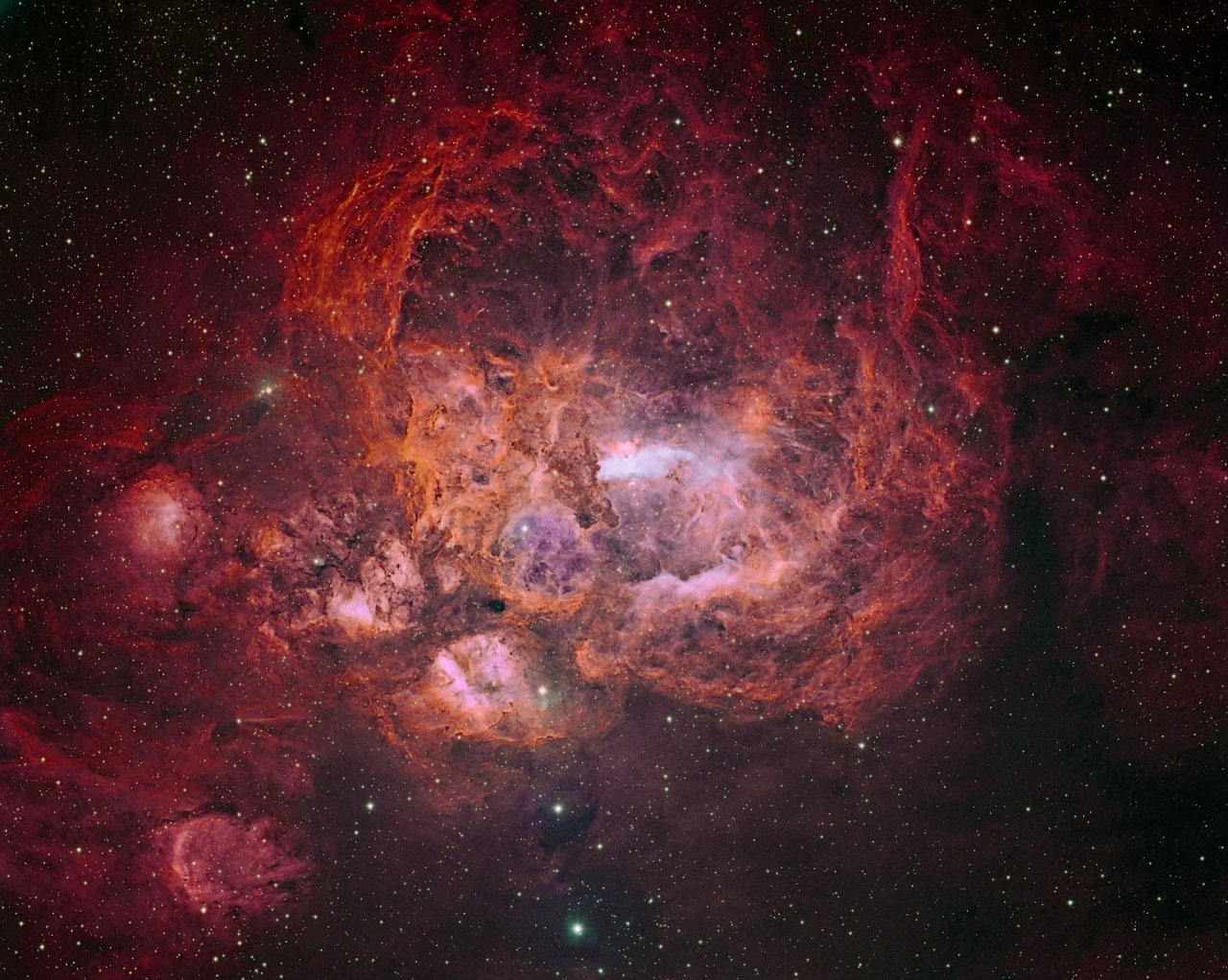NGC6357 is known as the Lobster Nebula, a diffuse emission nebula in Scorpius. It is also known as the War & Peace Nebula, based on the appearance in infrared light of a skull on the eastern side and a dove on the western side. No matter what you call it, this is a very dramatic nebula, with complex and varied structures throughout.
The total exposure (integration time) for this image is 13 hours, with roughly equal amounts of H-alpha, O-III, and S-II, all captured in Australia. I processed it by first creating a color image with H-a as red, S-II as green, and O-III as blue. I then removed the stars from this image, which allows the adjustment of color in nebulosity without getting strangely colored stars. This color adjustment is made necessary by the dominance of H-a/red. Without adjustment, most emission nebulae would appear almost entirely red. Finally, the H-a data was applied again as a luminance layer over the color image, which restores the stars and some details lost when the stars were removed.
Over the years I’ve standardized on a system of naming the intermediate image files that tells me what steps I took to create it. Central to this naming convention is the assignment of data channels to color channels. For a natural color image this is simply “RGB” – each data channel is assigned to the corresponding color channel. For narrowband images the assignments are arbitrary. The narrowband images from the Hubble Space Telescope (HST) are typically assigned as SHO; S-II to red, H-a to green, and O-III to blue (this puts them in order by wavelength, as S-II is slightly longer than H-a). When using all 3 channels I generally prefer HSO, as is the case here, but any order is possible. And it is also fairly common to mix 2 data channels into 1 color channel. For example, blue might consist of 75% O-III and 25% H-a. That particular mix is common because in natural color there will be some evidence of hydrogen in the blue and green channels due to the H-beta spectral line (wherever there is H-a there will also be H-b). In fact, visual astronomers sometimes use an H-beta filter to enhance contrast in certain nebulae because although the H-a light is always stronger, human vision is much more sensitive to the blue/green of H-b than it is to the deep red of H-a. When channels are mixed this way it gets confusing to just string together the H, S, and O letters, so I clarify it by putting a hyphen between the color channels. For example, “HS-S-OH” means that red is a mix of H-a and S-II (with H being the greater component), green is S-II alone, and blue is a mix of O-III and H-a. It is also possible to repeat a data channel, such as HOO, where O-III data is assigned to both green and blue color channels. This particular scheme is often used to create a color image when there is little or no S-II signal, and is called a bi-color image.
I also often make a bi-color image as SOO, not because there is no H-a signal (that never happens), but because S-II and O-III are both weak compared the H-a, making it difficult to combine all 3 directly. The SOO bi-color image is an intermediate file that is then combined with H-a by applying H-a as luminance data. This process means that luminance data defines the brightness (and thus most of the image contrast and detail), while the other data defines the color. In my file names I denote this luminance process as X(IJK), where X is the luminance source and IJK is the RGB sources, respectively. In the case I was describing above the luminance-combined image would be named H(SOO), and for the War & Peace Nebula image it is H(HSO). This function is also sometimes used in natural color. “L(RGB)” means that an actual luminance data channel (captured using a filter that passes the full visible spectrum) is applied over a straight RGB image. This is done because it allows you to put most of your effort into capturing just the L data, since it defines the details of the image, and RGB data can consist of relatively few and/or short exposures. I often blur the RGB image to reduce noise in it, knowing that sharpness will be restored by the L channel. This luminance process is based on the fact that our vision works much the same way: We see details mostly in luminance and are much less sensitive to “sharpness” in color. Compression of both still and video digital images makes use of the same principle, as did the original analog color television system.
More recently, I’ve started using a variant of the luminance function annotation system to indicate a “lighten” combination of 2 data channels. The “lighten” function in Photoshop produces an image in which each pixel is the brighter of the corresponding pixels in the 2 source images. This is useful in several situations, including composite images of meteor showers, where you want the background to stay dark, but add the full brightness of each individual meteor streak to the final image. I use square brackets instead of parentheses to denote the lighten function. For example, [HO](HSO) means that a “lighten” combine of H-a and O-III is applied as luminance over an HSO color image.
Beyond the basic channel combinations, I append abbreviated names for various filters and functions to the file name to indicate the processing steps. For example, the file name for the War & Peace image above is “NGC6357_H(HSO_starless)_ED_LCE_hue”. “ED” is a filter called “enhance DSO (deep space object)”, and “LCE” stands for “local contrast enhancement”. The final “hue” just means that I shifted the color hue, something I often do, although it would more commonly be done to the starless color image before the luminance process.
